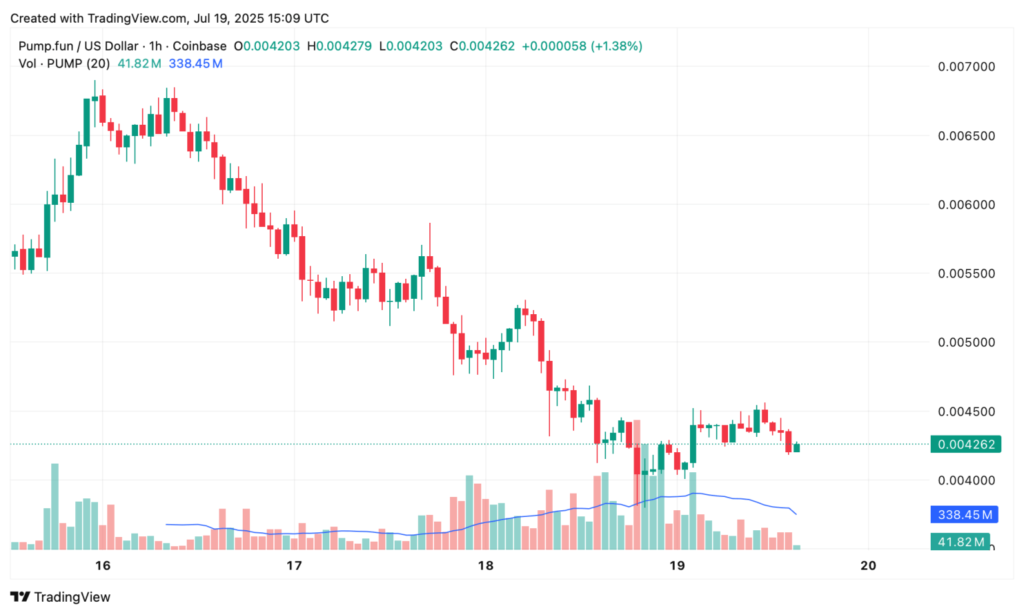PUMP Token Implodes: The Obvious Red Flags Everyone Ignored
Another day, another crypto carcass on the highway to Web3.
The PUMP token—once hyped as the next moonshot—just joined the 99% club. Here’s why its collapse was inevitable.
Zero Utility, Maximum Hype
No products. No partnerships. Just a Telegram group and influencers screaming 'ATH incoming!' Classic.
The Rug Pull Playbook
Dev wallets dumped harder than a trader after a 2% dip. Liquidity vanished faster than a Bitcoin maximalist’s patience.
Lesson? When a token’s whitepaper reads like a meme and its roadmap is 'trust us bro,' maybe—just maybe—it’s a Ponzi.
Meanwhile, Wall Street still charges 2% fees for index funds. At least their scams come with leather chairs.

In brief
- The PUMP token dropped over 37% after a historic peak, revealing an ICO without safeguards or real utility.
- 20% of the earliest crypto investors massively liquidated, triggering the token’s collapse.
- +3.4% rebound reignites the debate: sustainable recovery or just a speculative spasm?
Pump.fun: the $500M dream that falls short
Pump.fun ROSE to the ranks of the largest ICOs by raising nearly 500 million dollars, positioning its PUMP token as one of the most followed projects in the memecoin sphere. On July 16, the frenzy pushed the token to $0.006812, before market reality quickly corrected this exuberance. In less than 24 hours, the euphoria gave way to a drop of more than 37%! Revealing the extreme fragility of the crypto project.

Why did the PUMP token collapse so fast?
Pump.fun’s PUMP token peaks then plummets – is the party over? This question perfectly summarizes the disillusionment experienced by investors after an euphoric rise. It was not an external attack or a bug that caused the collapse, but the economic model itself. 20% of the crypto holders from day one took advantage of the peak to liquidate their positions, initiating a downward spiral. This dynamic is typical of projects lacking safeguards:
- No structural audit;
- No serious liquidity reserve;
- No buyback mechanism or supply management.
Pump.fun combined the ingredients of a programmed crash, where the slightest loss of confidence triggers an Avalanche of sales.
PUMP vs Bitcoin: two visions of crypto
This kind of drop invites comparison with Bitcoin, whose fundamentals rely on a proven infrastructure, a transparent monetary policy, and a history of resilience to crises. In contrast, PUMP relies on opportunistic tokenomics, disconnected from any real utility. Where Bitcoin is a hard asset with growing institutional adoption, PUMP is merely a speculative projection dependent on a fleeting hype cycle.
BTCUSD chart by TradingViewThis comparison emphasizes the urgent need for crypto investors to distinguish a structured protocol from a mere marketing product without a solid foundation.
PUMP rebound: hope or delayed trap?
Despite the collapse, the crypto token recorded a +3.4% increase in 24 hours, reaching $0.004494 according to CoinGecko data. This technical surge is not enough to reverse the trend. It rather invites reflection: is it a speculative rebound or a precursor to stabilization?

As it stands, the lack of real use cases and the capital flight dynamics suggest a simple respite before a new phase of volatility.
The Pump.fun case crystallizes the excesses of a crypto ecosystem attracted by quick gains, often at the expense of solidity. While some see this as a mere correction, others read it as a symptom of an ideological bubble. Can memecoins still claim lasting legitimacy in the markets?
Maximize your Cointribune experience with our "Read to Earn" program! For every article you read, earn points and access exclusive rewards. Sign up now and start earning benefits.

